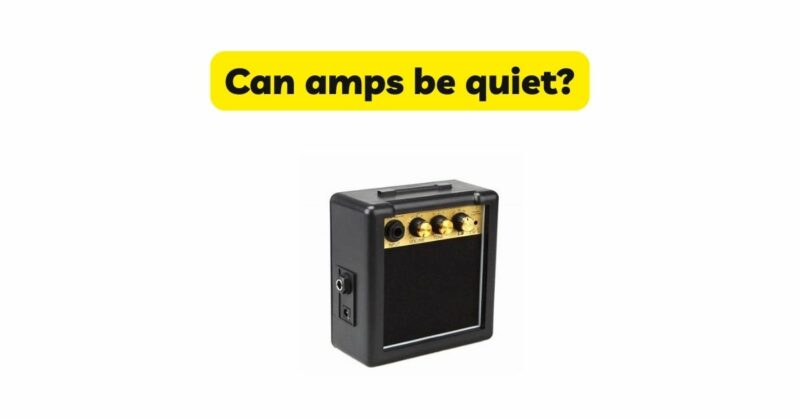Amplifiers, renowned for their ability to amplify sound signals, are typically associated with power and volume. However, there are instances where the need arises for quiet amplification, whether it’s for practicing in a noise-sensitive environment, recording in a home studio, or achieving a subtle ambiance in certain musical genres. In this article, we delve into the realm of low-volume amplification and explore the question: Can amps be quiet? Join us as we unravel the possibilities, techniques, and considerations involved in achieving quiet amplification without compromising sound quality.
Understanding Amplifiers and Volume: Before delving into the realm of quiet amplification, it’s important to understand the nature of amplifiers and their relationship with volume. Amplifiers are electronic devices designed to increase the amplitude or power of an audio signal. They provide the necessary gain to drive speakers or other audio output devices, resulting in a louder sound. Volume, in this context, refers to the perceived loudness or amplitude of the sound produced by the amplifier.
Challenges of Achieving Quiet Amplification: Achieving quiet amplification presents unique challenges because traditional amplifiers are optimized for delivering higher volumes. However, advancements in technology and the emergence of specialized equipment have made it possible to explore the realm of low-volume amplification. Here are some key challenges to consider:
- Signal-to-Noise Ratio: One significant challenge in achieving quiet amplification is maintaining a high signal-to-noise ratio (SNR). As the amplification level decreases, the inherent noise present in the amplifier circuitry becomes more perceptible. Maintaining a clean, noise-free signal becomes crucial for achieving high-quality, quiet amplification.
- Distortion: Amplifiers operating at lower volume levels can be more prone to distortion. As the signal level decreases, the dynamic range of the amplifier is reduced, potentially introducing unwanted distortion or artifacts. Minimizing distortion is essential to preserve the integrity and fidelity of the audio signal.
Techniques for Quiet Amplification: While traditional amplifiers may not be inherently designed for quiet amplification, there are several techniques and approaches that can help achieve lower volume levels without sacrificing sound quality. Here are some methods to consider:
- Attenuators and Volume Controls: Attenuators, devices used to reduce the signal level, can be employed between the amplifier and the speakers to achieve lower volume levels. These devices allow fine-tuning of the output level, enabling more precise control over the sound volume. Similarly, the amplifier’s volume control can be adjusted to a lower level to achieve quieter amplification. However, it’s important to note that simply turning down the volume control may not always result in optimal sound quality, as amplifiers are typically optimized for a specific range of volume settings.
- Low-Wattage Amplifiers: Low-wattage amplifiers, often referred to as “practice amps” or “bedroom amps,” are specifically designed for lower volume applications. These amplifiers typically have lower power ratings, allowing for quieter amplification without compromising tone or sound quality. They are ideal for practice sessions, home recording, or situations where volume needs to be kept to a minimum.
- Headphone Amplifiers: Headphone amplifiers are designed to provide amplification specifically for headphones. They allow for quiet amplification by directing the audio signal directly to the headphones, eliminating the need for loudspeaker output. This enables musicians, audio engineers, and enthusiasts to practice, monitor, or mix audio without disturbing others.
- Digital Modeling and Direct Recording: Digital modeling technology has revolutionized the way we approach amplification. Modeling amplifiers utilize digital signal processing algorithms to simulate the sound characteristics of various amplifiers, cabinets, and effects. These amplifiers often have built-in headphone outputs and line-level outputs, allowing for quiet practice or direct recording without the need for traditional loudspeakers.
- Soundproofing and Isolation: In certain scenarios, achieving quiet amplification may involve addressing the environment itself. Soundproofing techniques, such as acoustic treatment, isolation pads, or enclosures, can help reduce the sound transmission from the amplifier. By minimizing sound leakage, reflections, and external noise interference, you can create a quieter environment for amplification.
Considerations for Quiet Amplification: When pursuing quiet amplification, it’s essential to consider the following factors:
- Tone and Sound Quality: While achieving low volume levels, it’s crucial to maintain the desired tone and sound quality. Experiment with different amplification techniques, settings, and equipment to find the right balance between quiet amplification and tonal integrity.
- Dynamic Response: Lower volume levels can impact the dynamic response of an amplifier. Experiment with the amplifier’s controls, such as gain, tone, and compression, to achieve the desired dynamic range and responsiveness while maintaining a quiet output.
- Compatibility with Instruments and Genres: Consider the compatibility of quiet amplification techniques with your specific instrument and musical genre. Different instruments and genres may have varying requirements and tonal expectations at low volume levels. Tailor your approach to suit the unique characteristics of your instrument and the musical style you are aiming for.
- Flexibility and Versatility: Ensure that the chosen equipment and techniques for quiet amplification offer the flexibility and versatility needed for your intended application. Consider factors such as portability, connectivity options, and the ability to adapt to different performance or recording situations.
Conclusion: While traditional amplifiers are primarily designed for delivering higher volumes, achieving quiet amplification is indeed possible with the right techniques and equipment. By employing attenuators, low-wattage amplifiers, headphone amplifiers, digital modeling, or soundproofing methods, you can explore the realm of low-volume amplification without sacrificing sound quality. It’s important to consider factors such as signal-to-noise ratio, distortion, tonal integrity, and compatibility with instruments and genres when pursuing quiet amplification. With careful consideration and experimentation, you can find the perfect balance between low volume levels and high-quality sound reproduction, enabling you to practice, record, or create music in environments where minimal volume is required.


